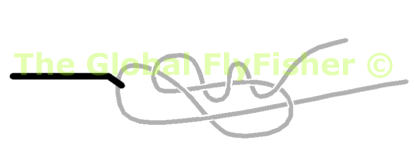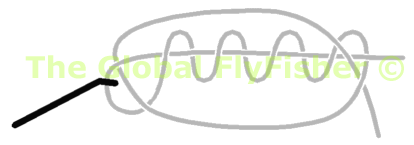How to Tie a Needle Knot Fly Fishing
A test in the print magazine Fly Fisherman showed the Trilene and the Orvis knot to be equally strong and on top of that said that they were able to maintain 100% of the line strength. I really have my doubt if that will hold for all types and thicknesses of line, but still it does prove that these could be the knots of choice for the concerned fly fisher.
I personally prefer knots that pass the line through the eye twice - like the Trilene and the Palomar knot. My favorite loop knot is the Surgeons loop which is easy to tie and has served me well. If I need a guiding knot, I tie the Moerrum Guiding knot.
| Fly attachment knots |
Palomar knotA knot that is easy to tie and has a good breaking strength of over 90%. It can be difficult passing the line twice through the hook eye, but pass the tag end though one way first and then back. Then make the loop as small as possible and pass it over the hook. Tighten by first pulling both ends - then the tag end alone. |
Surgeons loopA loop which can be used to tie on small flies or flies that need to work on the leader. The knot is strong, but the open loop is a bit fragile where the fly wears it, so the knot ought to be inspected and retied regularly. Make sure you do not tie the loop too large as it and the knot has a tendency to grab any material on the fly and lock. This will often lead to a fly swimming backwards... |
Duncan loopThe classical loop for flies that need to work freely on the tippet. Fairly easy to tie and can be tightned according to taste. |
Orvis knotCan form a loop that tightens when under strain. Its strength almost compares to the Trilene knot with a 95% avarage. |
Figure 8 loop |
Trilene knotThe breaking strength is very high for this knot; very close to 100% for some lines and diameters and almost always above 90%. Do not cut the tag end too close. The knot has a tendency to untie itself after many casts. |
Moerrum Guiding knotA guiding knot well suited for up or down eye flies on heavy tippets – especially salmon flies. The knot is easy to tie with a good breaking strength. Tighten the loop section first and then work it slowly to a position in under – and almost in – the hook eye. |
Improved clinch knot (not recommended)This is a very common knot, but even though it seems to look much like the Trilene knot, it's very weak in comparison. Down to 60% breaking strength in some cases. I do not recommend using it. |
| Leader knots - mono to mono |
Blood knotA knot used to tie two monofilaments together, i.e. tippet to leader or two pieces of a knotted leader. The knot is a bit difficult to tie, but can be tied without tools with some practise. It is compact and has a high breaking strength and leaves the line absolutely straight. The number of turns can be varied, but 3-5 turns work well on most lines. Cut the tag ends very close to the knot with a clipper to keep them from grabbing all kinds of weed and debris in the water (not like in the picture, but as close as you can get).. |
Surgeon's knotThis knot is normally used to tie two monofilaments together, i.e. tippet to leader. The knot is fast and easy to tie and has a high breaking strength. It does require one side to pass through the loop and is more bulky than the Blood knot. It also leaves a small angle on the line. The number of turns can be varied, but two turns work best on most lines. |
| Leader knots - mono to fly line |
Needle knotAn excellent knot for attaching the leader to the fly line. It yeilds a very neat, straight and strong transition between the monofilament leader and coated fly line. |
Nailless nail knotAn fine knot for field attachment of a leader to the fly line. It is almost as straight and strong as the above nail knot, but can fail if the coating is pulled off the fly line core. |
COPYRIGHT!
For some reason these illustrations and the text has become some of the most copied items on GFF ever... we can't really see why, but that seems to be the case. They have been used extensively all over the web without our permission. Because of this we have now overlayed all illustrations with the ugly green copyright text, making it just a bit more difficult to use the images without leaving traces of their origin. Leave no room for doubt: All this content is copyrighted! It can't be used anywhere else without our written permission.
![]()
![]()
![]()
How to Tie a Needle Knot Fly Fishing
Source: https://globalflyfisher.com/fish-better/illustrated-knot-table





















